
Gracilaria vermiculophylla
Mudflat Gracilaria, Japanese Gracilaria
16 July 2022
Ship Point, Baynes Sound, Strait of Georgia, B.C., Canada.
Tide: 1.3 feet at 14:27 PDT (measured at Comox Tidal Station)
Conditions: Partly cloudy, light variable winds 0 – 10 km per hour, sea smooth to rippled, humidity 70%, 14˚C.
Moon: Waning Gibbous (87%, 18 days); Previous Phase, Full Moon, 13 July 2022 at 11:37am PDT: Next Phase, Third Quarter, 20 July 2022 at 7:18am PDT.
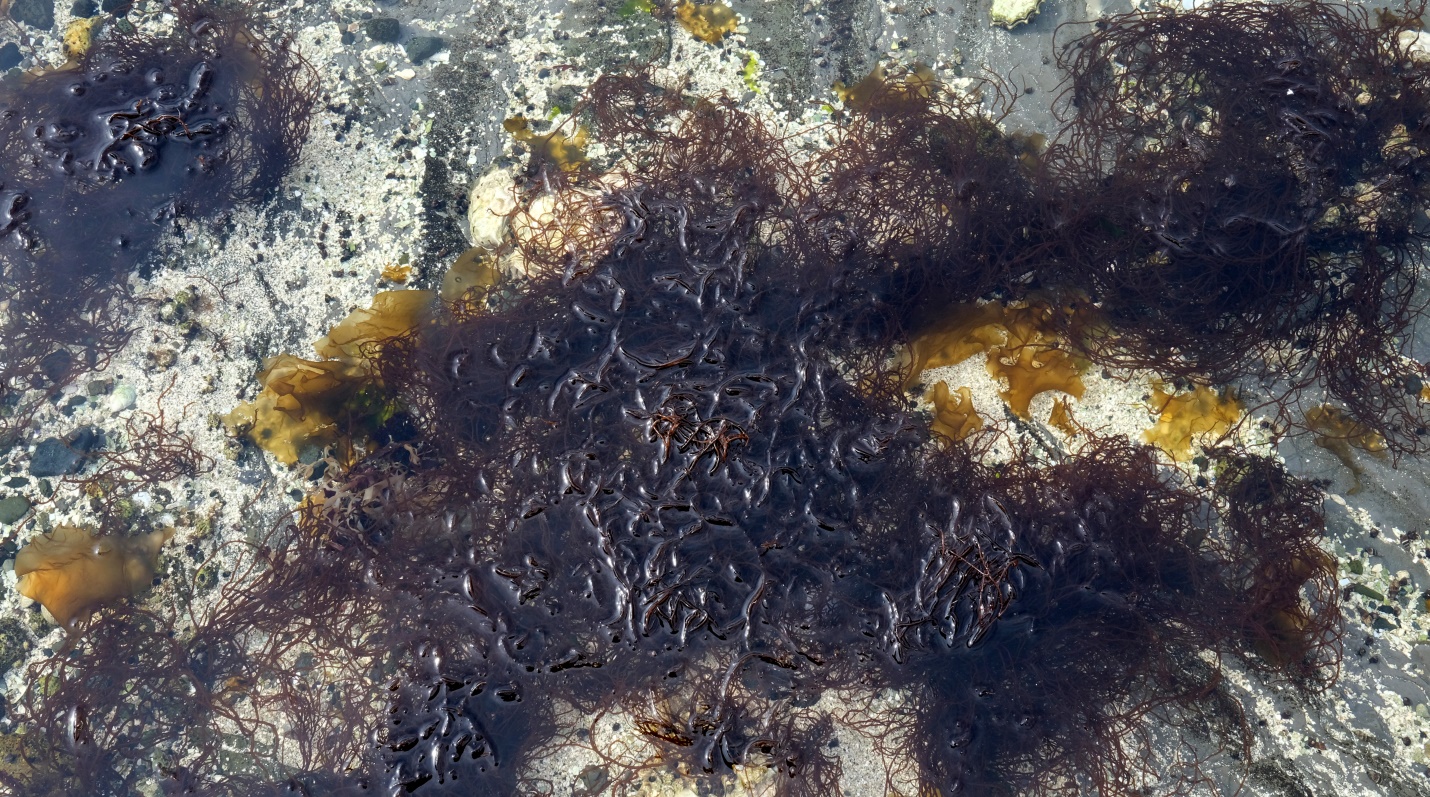
Figure 1: The ‘tangle’ of dark red/burgundy stems viewed floating in shallow water at Ship Point here are a few groupings of the red alga, Gracilaria vermiculophylla. Ship Point, Baynes Sound, Strait of Georgia, B.C. Canada. April 13, 2022. Photo ID: 27255 ©Seaweedwhisperings.com
Person 1:
This is an accidentally introduced species native to Japan.
Spread out over a shellfish lease (mainly oyster) in a man-altered shallow intertidal area.
Here this seaweed is a dominant aspect of the mid to low intertidal. It seems to like to attach to small rocks and shells.
We found it first in April where it was conspicuous but not so omnipresent as compared to what we see now in mid-July.
Looks like a tangle of reddish-brown spaghetti…, so whole, exotic grains, not processed white flour.
Most specimens are now covered in reproductive structures neatly adorning the myriad of branches emanating from thicker main axes. The main axes have very few of the reproductive structures.
Enough of physical description!
I sometimes see the branch ends resembling tentacles or antennae of crustaceans.
With my note making and thinking about this seaweed I am having trouble choosing between present and past tense.
Bewildered.
What’s it like to be transported far from your native land?
Were you forced?
Or did you flee?
Now, are you proliferating in a land of opportunity? Or are you struggling to survive, rapidly reproducing in hopes of persisting as a species?
Words and phrases that come to mind:
Noose (loops of branches).
Grasping (spines and hooks coming off the branches).
Omnipresent (reaching out everywhere on this mudflat).
Smothering (covering everything).
Bewildered (not thinking, just growing in all directions in disorderly fashion).
“Mudflat Gracilaria” looks rather unattractive. However, close up view of branches with the reproductive structures reveals a beautiful rounded simplicity, studded with black diamonds.
Even with all the snails grazing you, you are more or less oblivious to that, and are out to conquer and proliferate.
Maybe those “diamond studded” branches are actually weapons.
Maybe there is actually urgency in your desire to proliferate.
Can you only thrive in these disturbed environments?
Sense of edginess and uncertainty.
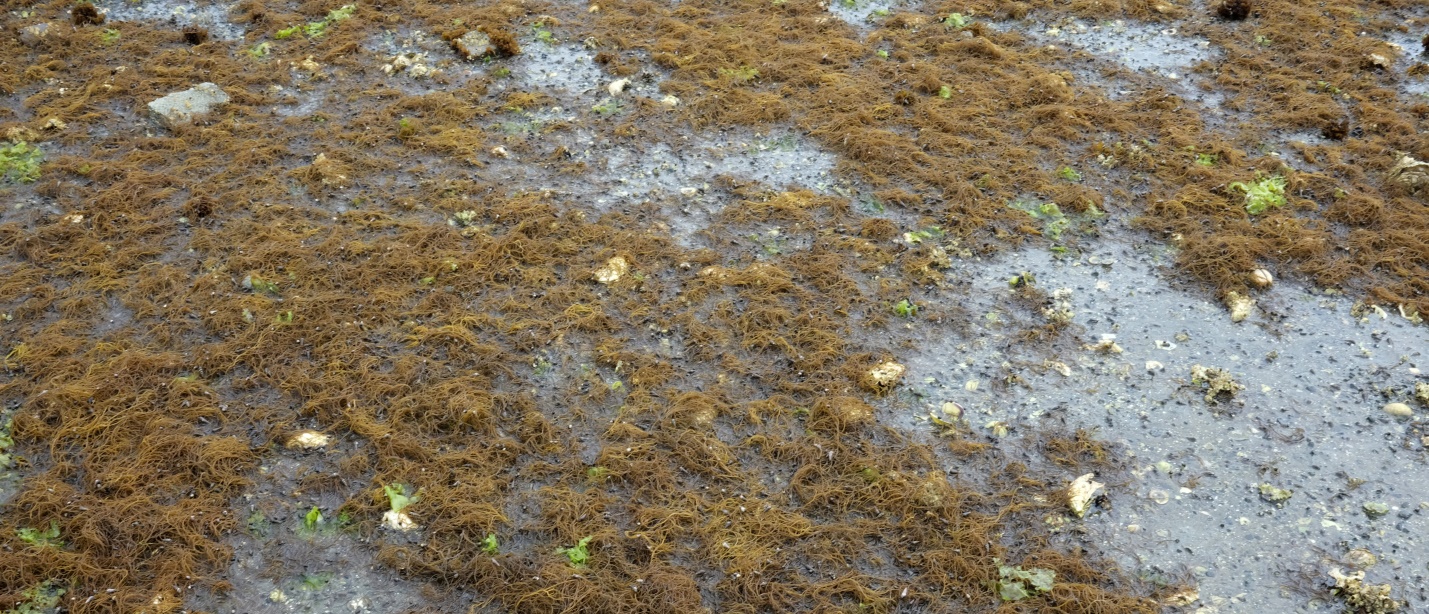
Figure 2: At the mudflats and oyster ‘lease’ of Ship Point, visited on a lower tide and in mid-summer, Gracilaria vermiculophylla algae that had been conspicuous in April were now omnipresent. As a group, this macro alga has a strong presence. Maturity, progression of the season and possibly low nutrient availability seems to fade this red seaweed to the yellow brown pictured above. Ship Point, Baynes Sound, Strait of Georgia, B.C. Canada. July 16, 2022. Photo ID: 27256 ©Seaweedwhisperings.com
Person 2:
Prolific.
Masses of tubular branches curled and curved and seemingly tangled together.
We found you here at Ship Point where there are extensive areas reserved for shellfish leases – the intensive production of favored species for human commerce and consumption.
This seaweed has the feel of being out of balance here, overpopulated, opportunistic, very successfully so, and in terms of this specific habitat, exotic and invasive.
This feels like a recent occurrence, not something that has had ‘time’ to settle or adapt.
What and who is this “newcomer” or “alien” displacing…, replacing…, out-competing…?
It seems as if once it gets a foothold, or maybe it doesn’t even need much of a foothold, Gracilaria vermiculophylla just takes off.
No hesitation, no limits.
Grows and grows.
The tubular [I use the word tubular but I’m certain it is not hollow at the core, therefore is a better word cylindrical…, that doesn’t feel much more accurate, it seems that I don’t have the correct vocabulary…, is that part of being an ‘alien’…, yes, for sure!]…, so, the tubular/cylindrical thallus “does the job” admirably but it is not in my estimation “a thing of beauty”. It is rather irregular in its shape, looks solid, but also somewhat translucent. The main stems all send off tiny curling branchlets at irregular spacing; these head off in all directions from the main thallus, and it looks like these branchlets might serve to hook up /tangle up with other neighboring Gracilaria stems very successfully. Numerous larger branches also grow from the main thallus. This forms a mat, a tangled carpet of algae that is not solid, but that is, in its own way, interwoven and connected as a kind of ever enlarging entity.
There is a kind of molasses red brown color to this seaweed in spring; this was observed in mid-April. Now, back at this same location in the same year but three months later (mid-July), the color of the Gracilaria stems has changed/faded to a more olive/yellow/golden/green. And a notable change now is that in nearly all of the plants I examined, all of the side braches are profusely dotted with bulging, spherical, reproductive structures. These rounded reproductive structures retain the same red brown color that the whole seaweed had earlier in the season. The reproductive structures are so numerous that I didn’t attempt to count them.
Again, prolific AND prolifically fertile!!
When I looked closely at this seaweed that is now covered with its reproductive structures and spent some time to experience this, I was impressed with what I can best describe as a ‘glowing’ beauty to this obvious fecundity. The beauty inherent here should be attributed, I believe, to the awesome power behind this reproductive expression of Gracilaria – and that is the urge to live! And as part of that living to also create new life. So, this is procreation, not as a simple begetting of offspring, but as I sensed it this day with Gracilaria, as a naturally beautiful expression of one part of the cycle of life.
Grow and reproduce, grow and reproduce, grow and reproduce. On and on, with vigor!
But the impact of this effort is also lacking in grace.
There is no courteous regard or goodwill for others.
The energy has an aspect to it that is even boorish – bad mannered, coarse and uncivilized in the sense of disregard for anything else except grow and reproduce, grow and reproduce, grow and reproduce!
Gracilaria vermiculophylla you are intent on your goals; you put all of your energy to them.
Nothing seems to deter you, stop you, or even slow you down much, in your pursuit of these goals.
You do not occupy a place in the community.
You don’t fit in with your neighbors. There has been no time for that to be established – the thought actually hasn’t even occurred to you to attempt that. No, your imperative was to tend to your own survival, and also, inexorably intertwined with your personal survival, the survival of your offspring as well.
And the way you grow, so tangled up with yourself and your kind, well, you don’t seem to look out at and observe or consider others around you all that much at all.
So, you are not liked.
Those who were established here before you arrived are disturbed by your presence, in some cases, greatly so.
You’re like the immigrant or refugee or foreign worker who arrived in a new land with few possessions and little material wealth. What did you have to your advantage then – the necessity and the ability to work hard at your goals. In this new place there are opportunities and there are at least some resources, so you got down to work! And you were very willing to put in that work; you sought no permission, you simply got down to work and while doing so, proliferated. In many places you not only survived, you even thrived, and in so doing others quickly came to resent your successes. Those resentful ones overlooked how unwavering you were, how much energy you were pouring into your efforts.
Even though you are aware of it, their resentment of you doesn’t affect you much. If you have much time to spare a thought about it, you might find their attitude only reinforces your habit to keep to your own kind, to proceed with your goals and to unapologetically carry on with them.
Does anything cause you to pause and take note of those you have recently displaced? The ones who are gone because you are now here? It doesn’t appear so – such is the forcefulness of your “get established then grow and reproduce” imperative. But around you, the others who persist in the neighborhood from before your arrival, they do recall, often with inflated virtues, the memory of those others whose space you’ve taken, the ones who have been displaced. Your presence has changed things, upset the former balance.
The original ‘natives’ in the area, they measure and compare you, often unfairly.
How could you compete with something / someone who is gone, a ghostlike presence that you never knew, anyway?
This is a memory that others hold and you have no knowledge of.
You cannot make any amends – that is impossible.
So, you conclude that you’ll carry on, just as you have been doing.
The new community you are “landed in” is strange to you. You are strange to them. There is not much understanding in either direction; maybe you can’t even communicate with more than gestures and a few newly learned words. One thing is for certain, everyone knows that you “aren’t from around here”, that “you don’t really belong”.
Since you are the ‘newcomer’, the question arises, “why did you arrive here?”
Was it your choice, Gracilaria?
Or was it some twist of fate, some event you had no control over?
Swept up and away, do you recall where you came from?
Of course you do, your homeland is in your every cell.
Possibly this is why you grow so prolifically, as a way to reach out for and to cherish again a familiar “taste” of some favored foods, another “view” of a remembered landscape, that certain “smell’ carried on the spring breezes, or perhaps the “sound” of a few notes of birdsong that belong to the home that you are now so far away from.
The ache in your heart for these past experiences is at times profound as you now know that only memories can be yours. Your whole community, your culture, your familiarity with other organisms you shared your environment with, even the arrangement of the constellations of stars in the night sky – these are changed, hardly recognizable or gone entirely from your life now. You have no way to get them back.
There is no way back, only forward.
Forward, where you are.
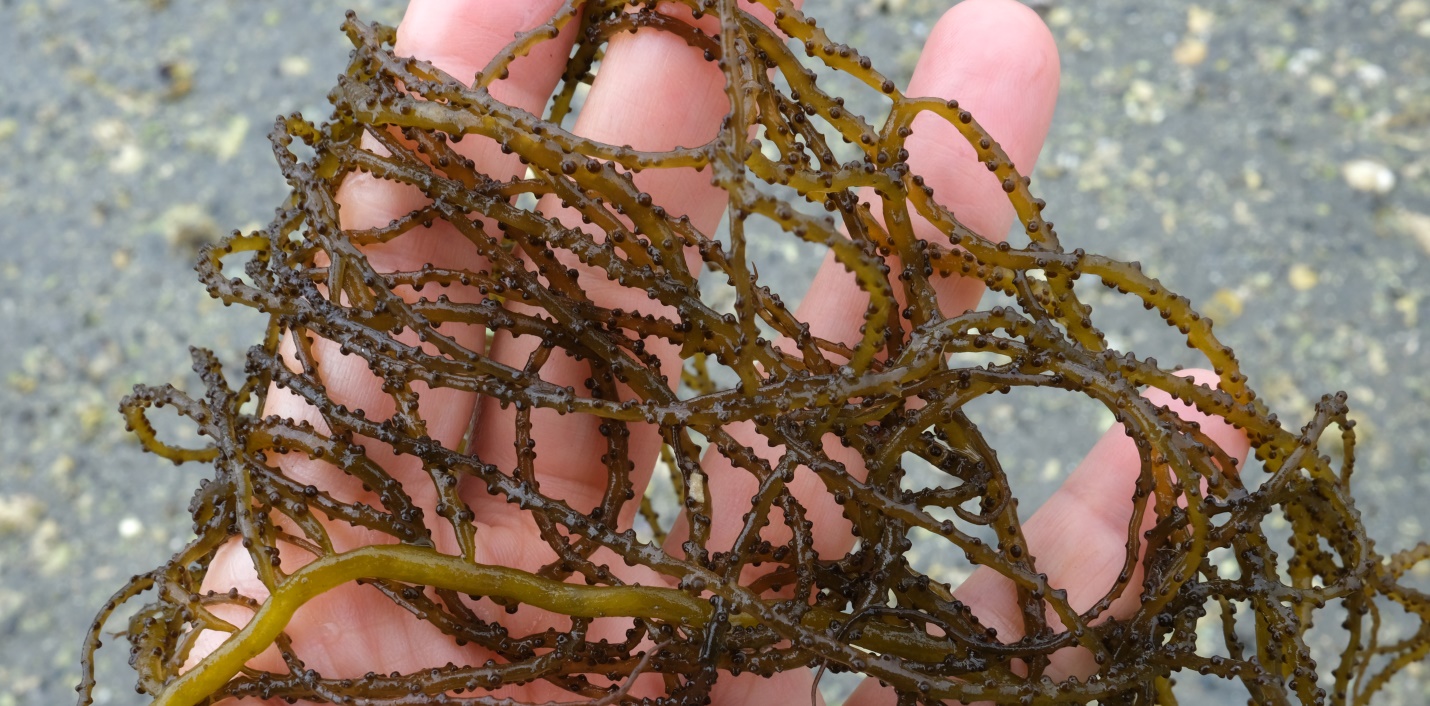
Figure 3: A closer view shows the thalli and branches of Gracilaria vermiculophylla as it can look when profusely dotted with reproductive structures. Ship Point, Baynes Sound, Strait of Georgia, B.C. Canada. July 16, 2022. Photo ID: 27257 ©Seaweedwhisperings.com
Discussion:
While working with the write up of this Whispering, we came across a quote from a novel entitled ‘Endangered Species’ by Nevada Barr. The passage struck a common note, several chords to be more precise, with the energy of this seaweed. To quote, “plants grew with the voracious disregard of the condemned, springing from the rough ground in impenetrable thickets to fight for light and air…”
“Voracious disregard”…, yes, it would seem that this seaweed’s life situation is pointing to the question of how living in balance with the world you inhabit actually can come to be. Does this balance not find its origins by first knowing your surrounding life forms, your neighborhood, and the members of your world as far as you can experience it? Knowing – the simple recognition of these ‘others’ you share your environment with, is this not the first and vital step towards understanding? Towards accessing respect and love and a suitable place for all? This can require the courage and humility to truly and objectively inquire and explore, and then also the frank honesty and overarching wisdom to see one’s place in relationship to others and adapt and adjust accordingly.
Gracilaria does not lack courage or humility or respect or the heartfelt ability to love. Not at all! But what is missing? It seems it is painfully simple. It is that first crucial step, knowing others – a familiarity and awareness and experience with the different contributions and natural interrelatedness of all the players within its new environment. Without knowing something / someone how can it / they be understood? Without understanding, how can they be valued? With a limited season to grow and reproduce, how can the newcomer take the time to become fully acquainted, to learn and to amass this knowledge?
Without the wisdom that comes from truly understanding the whole environment around them, what it comes down to is just what the quote from ‘Endangered Species’ indicated, a “fight” – a blatant and perilous competition. There is even a frantic pace and a desperation underlying this fight that generates a rather alarming or edgy feel – it is a careless race to gain the most resources and territory. In spite of the innate beauty of the seaweed as a species itself, with its ignorance of balance and place within its ecosystem, it is reduced to enacting the raw struggle of survival.
Gracilaria vermiculophylla, like many ‘alien’ species who are ‘invading’ new territory, is almost solely striving for its physical survival. Driven by circumstances not of their own choosing, this ‘landing’ in a new region can bring losses and great changes and unimagined stresses to the native species. There is no “being a part of” the whole ecosystem, nothing anywhere near that yet for the newly landed ‘intruder’ and the resident ‘natives’. That has not yet been established; in fact it’s a process that has barely begun. And if enough time and resources permit a new balance to be reached, what will ultimately exist is a different ecosystem than was originally there. There truly is no going back, only ‘forward where you are’.
What is missing in this life of struggle for survival? What happens when suddenly a species is thrust into that battle for survival from a former existence that was lived in an established harmony with others? What is important in life is the kind of wealth that comes from connectedness to family and community and environment, the richness that is deeply rooted in these complex associations. To what part of their being do all their previous cultural awareness and civilized understanding and respectful associations with others go to? Is it lost to them, or is it forcibly supplanted? Rudely displaced? Traumatically superseded by the pressing imperative to grow and reproduce, grow and reproduce, grow and reproduce. Is there not held within this most essential survival drive the tiny seed of hope for a future time and generation that may once again embrace and enjoy the qualities of living as “a part of” a whole and dynamically balanced community? Gracilaria would say, yes, there absolutely is.
One could argue that this state, newly displaced and desperately striving for simple survival is a part of the ‘dynamic’ whole. And in that context, this seaweed then truly embodies the energy of the forces of recent or sudden change, the newest beginnings of a future not yet imaginable. Also integral to this seaweeds energy is the amazing ability to adapt and prosper in a foreign place, to quickly recover from huge trauma and to move forward with life. There are others who would perish when facing those kinds of goals. So, Gracilaria vermiculophylla, you have certain qualities that are beautifully suited to the circumstances you so regularly face. While others around you may scorn you and indeed ‘condemn’ you, you draw from a deep set of innate abilities and with their own type of beauty these serve you in your ability to thrive and to flourish – even in perilous circumstances and against difficult odds.
At one point in our interactions we felt that part of the energy of this seaweed felt as if it was lacking “grace”. Given the name of this seaweed, G-R-A-C-ilaria, it felt appropriate to check the etymology of this word. References suggest that grat-, gra- and grac- are derived from the Latin, beloved, pleasing, dear, agreeable, grateful, thankful, pleased. Perhaps the thankful and beloved sentiments are all experienced and held safely within for this rapidly colonizing alien alga. And then also in their newfound environment the very presence of Gracilaria vermiculophylla very dramatically challenges the natives with respect to their own ability to access grace as well.
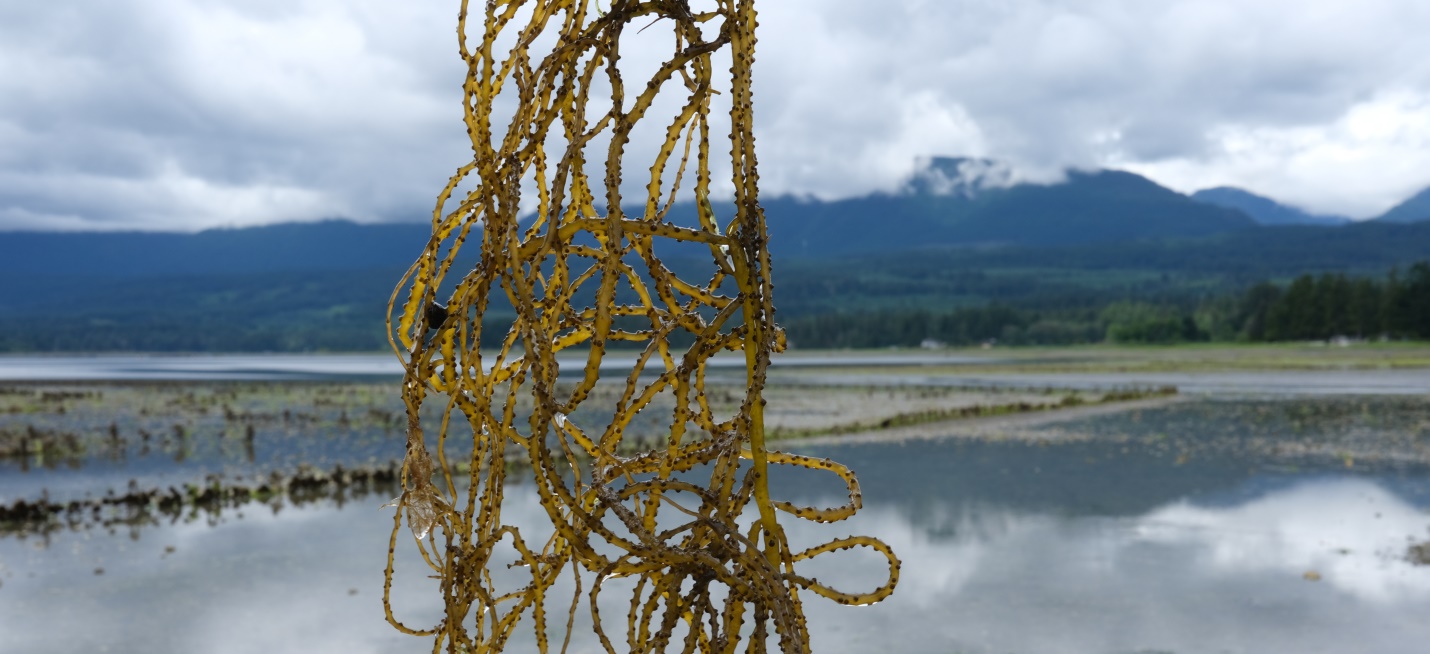
Figure 4: Held in mid-air with the human altered shellfish growing area as backdrop, this tangle of Gracilaria vermiculophylla exhibits some of its key characteristics. Ship Point, Baynes Sound, Strait of Georgia, B.C. Canada. July 16, 2022. Photo ID: 27258 ©Seaweedwhisperings.com
Biology & Natural History Information:
Description:
This red alga is cartilaginous, cylindrical and grows to 50 cm in length. It is coarsely and profusely branched and anchors to rocks, pebbles, shells, fishing nets or can also simply form loose-lying beds. It is a perennial species with alternating generations. Gracilaria vermiculophylla reproduces by spores which are non-motile, so it is restricted to passive dispersal mechanisms. Male and female gametophytes and tetrasporophytes have a similar morphology. Characteristics of the reproductive structures are used for correct identification of Gracilaria species.
Habitat:
This macro alga can grow both in temperate and tropical regions and is well adapted to low energy, shallow bottom bays, lagoons, estuaries, harbors, mudflats and inlets. It forms extensive beds in the intertidal zone and also in the upper sublittoral zones. It can tolerate being covered with sand and mud and it can occur as pure stands to the exclusion of other marine macro algae and saltwater plants such as native seagrass beds.
Distribution:
Gracilaria vermiculophylla is native to the Northwest Pacific including the coasts of Japan, where it was first described, and Korea, China and Vietnam. It is an introduced species on both coasts of North America and Europe and is noted to rapidly colonize new environments.
Remarks:
This seaweed is widely used for the production of agar, which is used extensively in the pharmaceutical and food industries. As an introduced species Gracilaria’s impacts are varied and wide ranging. In some habitats it replaces or partially replaces native algal and seagrass communities, but in others it increases habitat complexity causing a rise in the diversity and abundance of invertebrates. This seaweed is highly stress-tolerant. Studies have shown it is able to grow in a wide range of temperatures (5 – 35 ˚C) as well as a wide range of light intensities and salinities. It is also tolerant of stresses including sedimentation, desiccation, grazing and low nutrients. Many articles are published on this species, often related to management as an invasive species; other times articles document date of introduction of this alga to new regions of the world’s oceans. For example routine barcoding of Canadian Gracilariales species revealed the presence of this invasive species in British Columbia (Saunders, G.W. (2009)).
Classification:
Phylum: Rhodophyta
Class: Florideophyceae
Order: Gracilariales
Family: Gracilariaceae
Genus: Gracilaria
Species: Gracilaria vermiculophylla (Ohmi) Papenfuss 1967
Former name(s): Gracilariopsis vermiculophylla Ohmi.
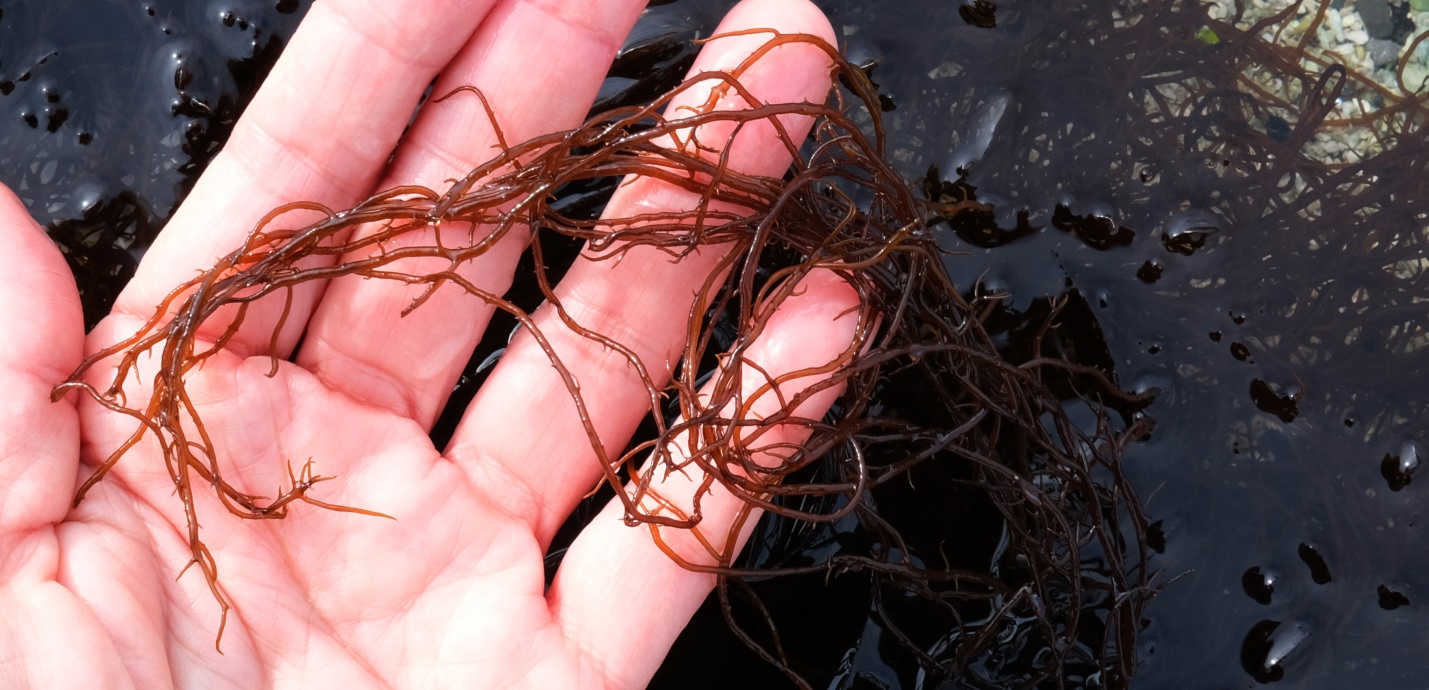
Figure 5: In mid-April, the morphology of this seaweed and its color is notably different; much growth is yet to happen. Ship Point, Baynes Sound, Strait of Georgia, B.C. Canada. April 13, 2022. Photo ID: 27259 ©Seaweedwhisperings.com
![]()